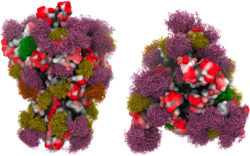We’re just over a week away from Thanksgiving and the start of the holiday season. In previous years, the season often brought anxiety, and a lot of people were cautious and took the extra step to update their vaccinations before visiting with family and friends at this very social time of year. Timely reliable data about viral spread is not as available as it once was, and that seems to be just fine with the general public these days. If Georgia’s low vaccination rate—with just 11% of the population getting the updated vaccine dose that was made available in September—is any indication of public sentiment, a lot of people are just no longer interested in taking the same precautions that were commonplace for many for the first two years of the pandemic.
Initial uptake for the updated vaccine was also plagued by distribution problems, similar to what Georgians saw in other rollouts of the vaccine and booster, but eventually availability became easier. For some residents, the problem was not availability, but rather how they were going to afford it. For the first time since the pandemic began, the government is no longer footing the bill, and some insurance companies were initially trying to charge patients rather steep prices. For those without insurance, the vaccine is available at the local health department, CVS and Walgreens, among other pharmacies, thanks to the BRIDGE access program.
At this point, the updated vaccine rollout is going more smoothly compared to its initial rollout, but there’s a lot less motivation to get the updated vaccine at this stage in the game. While wastewater data and Georgia Department of Public Health data both show lower rates of viral spread in comparison to last November, the virus is still following seasonal patterns and continues to spread.
In our current post-pandemic/endemic reality, the potential threat of the virus doesn’t even rank in comparison to the public experience at the height of the pandemic, and people are just generally less motivated to get vaccinated. A lack of precaution and low vaccination rates can’t just be tied to one or two factors. Our lengthy experience with the looming threat of viral spread has affected public behavior in this third year and shows no signs of changing any time soon.
For cardiologist Jayne Morgan, executive director of health and community education and former executive director of the COVID-19 Task Force at Piedmont Hospitals, low vaccination uptake and other changes in public behavior in the U.S. is the result of a long list of factors. “Many people believe that the current variant is mild or of little consequence,” she said. “And COVID-19 fatigue also continues to plague public behavior as well.” Then there’s the continued dissemination of misinformation about the virus, as well. And the list goes on, said Morgan.
“We continue to see diminished trust in our regulatory agencies, such as the FDA and CDC,” she said, “and political polarization also continues to play a large part in low vaccination rates now. Democrats are more likely to receive an updated vaccine than Republicans, and we see similar demarcations with flu shots as well.” Despite current low vaccination uptake, social norms and expectations may help explain why recent polling data shows that many adults say they still plan to receive the booster dose of the vaccine before the end of the year.
Many of these same adults with children do not plan to have their children immunized, she added, “because many parents feel that it is unnecessary for healthy children.” The trend is concerning for public health experts. “Certainly in this prolonged wave of milder disease, that could be a correct calculation on the part of parents. However, there are many children who have chronic conditions who could be devastated by a COVID infection.”
Public behavior and views about COVID-19 have veered into a path that will continue to promote the existence of the virus in our communities for the foreseeable future. “The ‘me instead of us’ and ‘I instead of we’ mentality, the view that ‘it’s not my problem,’ is short sighted,” Morgan noted. In fact, quite the opposite is true. It’s everyone’s problem.
“We, as a society, have not been able to put this virus to bed,” she said. “Arguably, although it may be in the rear view mirror currently, we are still having to glance into that mirror and check. Still having to look over our shoulder. Further, although you may escape more severe disease if infected, not only may others not and suffer greatly, but both you [with mild disease], as well as the person with severe disease are serving as vessels for further mutations to arise. And round and round we go.”
Rates remain much lower than previous years, but the last year has not been without new cases and deaths. In Clarke County, from Nov. 9, 2022 to Nov. 8, 2023, there were still 1,909 new cases reported to DPH. Given that many people stopped testing altogether or used at-home testing that isn’t reporting to DPH, that’s not a small number. COVID killed 21 Athens residents in the past year, bringing the total deaths to 254.
“The concern is less the wave of infection, but whether the wave of flu, RSV and COVID would all crest at the same time,” Morgan said. “Last year, we escaped a tridemic because COVID peaked after the peak of the flu and RSV season. There is no predicting nor preventing this. We just have to wait and see. Without real time data from the community, we have to rely on wastewater, hospital admissions and deaths. Thus far, hospital admissions have plateaued for the past two months… Adding to this is the fact that many do not even bother to get tested even with home tests. And so not only is the data not reported, there is little to report as it is often not created nor gathered.”
Now is a good time to get vaccinated for COVID-19, the flu and RSV. Both the flu shot and the COVID updated vaccine can be given at the same time. The RSV vaccine should be spaced from those two and given during a separate visit.
Like what you just read? Support Flagpole by making a donation today. Every dollar you give helps fund our ongoing mission to provide Athens with quality, independent journalism.









